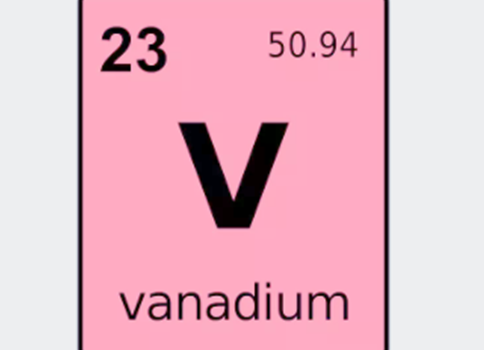The addition of vanadium(V) to steel can not only deoxidize and dinitrogen but also improve the properties of steel. Vanadium is rarely added as a single alloying element, except in carbon tool steels in quantities not greater than 0.05%. It is always used in conjunction with other alloying elements such as manganese, chromium, tungsten and molybdenum. For ball-bearing steel, nitride is harmful to its fatigue life, the damage of 5μm Nitride is equivalent to that of 20μm oxide to the fatigue life. It is usually not suitable to add vanadium to ball-bearing steel in the form of vanadium-nitrogen alloy unless the nitride can be reduced to less than 1μm, of with the size the nitride is not harmful but can refine the grain and enhance the dispersion. High strength and low alloy steels, high-speed steels, tool steels, stainless steels, spring steels and bearing steels all contain a small amount of vanadium, which has the characteristics of high strength, toughness, wear resistance and corrosion resistance, has been widely used in machine manufacturing, automobile, aviation, railway transportation tools, Bridges and other industries.
V For HSLA Steel
A large proportion of vanadium is used in the production of high-strength low-alloy steels. The addition of vanadium in ordinary low alloy steels can improve the strength, yield ratio and low-temperature toughness after normalization, and improve the welding property. In low-temperature structural steels, vanadium alloying can also be used to improve the strength and toughness of steels, with a content of 0.04% ~ 0.12%, and some up to 0.16% ~ 0.25%.
In alloyed structural steels, vanadium is mainly used to refine the grain size and improve the strength of the steel, because vanadium will reduce the hardenability of the steel under general heat treatment conditions. It is usually used together with one or some of the elements of manganese, chromium, molybdenum and tungsten, and the content is generally 0.07% ~ 0.30%, and some reach 0.40% ~ 0.50%. Taking high strength seismic rebar as an example, HRB400 and HRB500 hot-rolled ribbed rebar have been widely produced by vanadium microalloying technology, which have good comprehensive properties. The main advantages are: high strength, yield strength is not less than 400MPa, tensile strength is not less than 570MPa; The carbon equivalent is not more than 0.50%, good welding performance, suitable for various welding methods; The strength-yield ratio (the ratio of tensile strength to yield strength) shall not be less than 1.25; Good strength and plasticity, good bending performance; It has high strain low cycle fatigue performance, low strain aging sensitivity and brittle transition temperature, and good seismic performance.
V For Alloy Tool Steel
Vanadium is widely used as an alloying element in alloying mold steels. Vanadium not only refines grain size, reduces overheating sensitivity, but also increases tempering stability and wear resistance. In hot work mold steel H13 and cold work mold steel D2, vanadium is the main secondary hardening element with a content of 0.1% ~ 5%;
Some mold steels have even higher vanadium content, such as A11 cold work tool steel, which has an even higher vanadium content of 9.75%. In tungsten high-speed tool steels, vanadium can prevent grain growth, improve the red hardness and cutting ability of the steel, increase the wear resistance, and finally extending the service life of the high-speed tools. In Germany, vanadium consumption in tool steel and high-speed steel accounts for about 1/3 of the total consumption.
V For Heat Resistant Steel
Vanadium in heat-resistant steel can form highly dispersed carbides and nitride particles, which grow up slowly and polymerization at a higher temperature, can improve the thermal strength and creep resistance of heat-resistant steel. The high-temperature precipitation of vanadium carbonitride significantly improves the high-temperature endurance strength of steel, so vanadium-containing steel is widely used in power stations and other heat-resistant steel fields. The V element in most heat-resistant steels is generally between 0.15% and 0.40%.
| Grades | C | Si | Mn | Cr | Mo | V | Al | W | Nb | N |
| T91 | 0.08-0.12 | 0.2-0.5 | 0.3-0.6 | 8.0-9.5 | 0.85-1.0 | 0.18-0.25 | ≤0.015 | / | 0.05-0.1 | 0.03-0.07 |
| T92 | 0.07-0.13 | ≤0.5 | 0.3-0.6 | 8.5-9.5 | 0.3-0.6 | 0.15-0.25 | ≤0.015 | 1.5-2.0 | 0.04-0.09 | 0.03-0.07 |
V For Stainless Steel
Vanadium has many applications in stainless steel. The content of vanadium in stainless steel is generally between 0.1% and 1.5%; Among them, UNS S42700Cr-Mo-V Martensitic stainless bearing steels contain 1.10% ~ 1.30% V, and UNS S42800 Cr-Mo-V Martensitic stainless bearing steels contain 0.90% ~ 1.15% V.
V For Spring Steel
Vanadium can improve the elasticity decline resistance of spring steel, increase the strength and yield ratio, especially the proportion limit and elastic limit, and reduce the decarburization sensitivity of steel during heat treatment. Cr-V spring steel 51CrV4 is a typical type of high alloy spring steel with vanadium content of 0.10% ~ 0.25%, can be used to manufacture heat-resistant springs with a working temperature of 500℃.
V For High-temperature Alloy
Vanadium has been used in some Hastelloy corrosion-resistant alloys. Hastelloy B alloy contains ≤0.60%, HastelloyC, HastelloyC22 and Hastelloy C276 alloy contains less than 0.35%, Hastelloy N alloy contains less than 0.50%, Hastelloy W alloy contains less than 0.60%. Due to the tendency of vanadium to promote the formation of σ phase, with little influence in the strength or stability of the alloy, it is generally not used in nickel-based superalloys except for A286 which contains 0.10 ~ 0.50% V and a few other alloys.







